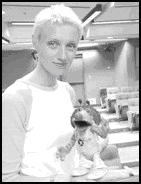Professional Focus

Time served Puppet Maker Patricia Brenan talks to us about armature making. Working in the industry for almost 20 years, Patricia has been with prestigious cutting edge of puppet making company Mackinnon and Saunders since its inception, working on productions such as 'Mars Attacks' 'Lavender Castle' and the upcoming feature, 'Fantastic Mr. Fox', and guest-lecturing at the UCLA. In an exclusive interview for Animation Toolkit.com, Patricia offers us her knowledge and reveals a couple of secrets to help you on your way.
Q. How did you first become interested in animation?
A. Like so many of my generation, I have to cite Star Wars for that one. I remember sitting in a cinema back in nineteen-eighty and watching the beginning of The Empire Strikes Back, expecting to see a movie like any other. The camera panned down onto a bleak snowscape and slowly pulled in on a Tauntaun running across the tundra... and I knew it wasn't real but there it was! It just blew my mind that someone could take something totally fictional and give it life. I knew that thing wasn't real- but there it was, running across the snow! That did it for me- I wanted to know how they did that and in finding out I just got pulled in. It wasn't enough to know how they did it; I wanted to do it too.
Q. Who inspires you? (past present).
A. Wow that's a toughie! I would have to say the old guard, so puppet makers such as Tom St. Amand, Lorne Peterson, Phil Tippet and Dennis Muren. And of course the likes of Ray Harryhausen, one of the real old masters. I guess I harken back to a time when special effects and animation was a craft and every new film had its own challenges to work out; no-one could sort it out with a little CG. I guess I like the idea of holding a physical prop in my hand- the fascination of knowing that someone actually made that object- that it exists somewhere.
Q. You have worked on many prestigious animation projects, which has been the most demanding and for what reasons?
A. I think every new project that comes along is the most demanding, because the stakes are upped literally every time. The bar is constantly raising, particularly in feature films. The latest film that Mackinnon and Saunders worked on (that's already on general release) was the Tim Burton film 'Corpse Bride', and I read in various places that the puppets were CG. I actually went on websites and said, "No, they're actual physical puppets with silicon skin." and had people tell me I was completely wrong! That's how good the puppets have to be these days- you need to make a head which may be five or ten centimetres in diameter look good in close-up on a fifty-foot screen!
In more general terms I think the latest challenge is the step up to high definition for general television productions, which is just beginning to make its presence felt in upcoming shows. It will have a huge impact on the way shows are produced. Everything- every single process that goes into a show- will have to be upgraded to deal with this leap in definition, and again its a case of raising that bar.
Q. What is your advice to a beginner/novice in building an armature, where is best to start?
A. My first armatures were wire. I didn't make my first full metal armature until I joined Mackinnon and Saunders, but back then it was very difficult to get hold of anything- for a start there was no internet! These days there are some great companies offering pre-packaged kits such as ‘Average Joe’ and it really is a great way to break into the field and get a feel for what the business is about. Even if you start modifying it the moment you get it out of the box (and what self-respecting armature-maker wouldn't!) then at least you have a framework to get you moving- if you'll pardon the pun. There are some great websites out there to help you along too like Animation Toolkit abdwww.stopmotionanimation.com but the best way you'll learn is to actually do it. If you get it right you'll feel great and if it all goes wrong, pick yourself up and dust yourself down and remember that's how we all learn. What's important is that you get out there and get your toe in the water- that's how you learn how to swim.
Q. Advanced puppet making such as geared head armatures and silicone casting are an art form passed from one master armature maker to another, what are your recommendations for people trying to get ahead in this area?
I think the advice is very different according to the reader. if you're making puppets because you want to animate, then remember that there are some fantastic, highly-regarded films out there which are solely mime, with no lip-sync at all. Anyone looking to put something impressive in their animation folio would do better to produce a few great pieces of mime with simple puppets than get all caught up in a very specialist field that needs a lot of equipment. Show what you want to do and what you'll do best- animate!!
For people looking to get into the puppet-making industry, I think within any company you need to expect to start at the bottom. No-one's expecting Amand to walk through the door. They're hoping to see someone with some good basic skills and a lot of enthusiasm. Jewellery courses (the type which teach metalwork rather than how to thread beads), are a great fountain of knowledge- if you can solder well and have a knowledge of metalwork, you're already halfway there. Again, there are great websites to discuss such things which have huge forums for everyone from the amateur through the enthusiast and semi-professional right up to professionals, all of whom chat and post there.
If you're looking to make a career of it, then I really do think its as much about personality as it is knowledge. Armature-making is largely a learned skill- if you're smart, patient and meticulous you can learn it, and with any good model making company, if they're offering a trainee position they expect to train you. If you turn up for an interview with enthusiasm- if you get over how much you want to learn, if you show you can work in a team and understand high-pressure deadlines, then you've set yourself up as well as anyone could hope to.
Q.Foam baking or silicone?
A. Ooh, toughie! Horses for courses, I'd say. Foam is user-friendly in that you can make it and bake it with minimum tools, but its a temperamental old thing and takes a while to learn. If its going wrong it can be very frustrating and you often have to know a hell of a lot to fix it. But its a joy to paint and to animate- though it will start to show wear very quickly.
Silicon is great if you're making block-colour puppets because its almost bomb-proof. Remember you'll always need an addition-cure silicon if you're putting it into moulds though (that's a silicon which has a separate catalyst) as air-cure silicon won't dry. If you want to paint it you're into a real minefield of appropriate paints and ways to get them to stick- by its very nature, nothing sticks to silicon except more silicon.
Also, consider hard-head puppets. A hard (hollow) resin head can be beautifully sculpted and cheaply made, is easy to paint to a high standard and will last a whole production. We still make hard-head puppets for TV shows at Mackinnon and Saunders and there are some great shows and shorts out there which use them.
Q. What words of encouragement would you offer to a student who is starting out in the animation industry?
A. I think the 3-D industry is changing at a phenomenal rate at the moment, but then we all expected it to with the arrival of CG. What's interesting is that 3-D has carved a real niche for itself- in terms of numbers, there are more 3-D animated films around today than ever. The amount of television is sadly going down, and that's important because for most animators, that's your bread and butter. There's a lot going on in terms of trying to save it though- lobbying parliament to give tax breaks to British productions as they do abroad, and passing legislation limiting the amount of foreign imports brought in to be shown on British TV and such, and students really need to start supporting that. That'syour industry they're taking apart; your future, so get out there and fight for it!
Our thanks go to Patricia Brennan of Mackinnon and Saunders for sharing a few words of encouragement. If you liked this article or found it interesting please let us know, your feedback is always welcomed.

